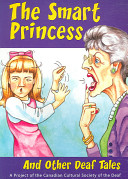
The Smart Princess and Other Deaf Tales
A Project of the Canadian Cultural Society of the Deaf
Written by Kristina Guevremont, Keelin Carey, Nicole Marsh, Nicolas Meloche-Kales, and Dena Ruiter-Koopmans
Second Story Press, 2006, 148 pp.
ISBN: 978-1896764900
The Smart Princess and Other Deaf Tales contains five stories that are all written from a Deaf person’s perspective about the challenges and misconceptions Deaf people face when interacting with a hearing counterpart. The stories also deal with the topic of loneliness.
The first story, “The Smart Princess” by Dena Ruiter-Koopmans, is about a Deaf child, a princess named Lyla, who despite being diagnosed by the doctor as not having the ability to learn, successfully learns sign language. Princess Lyla’s family learns sign language, except for snooty Aunt Belle who decides that Princess Lyla needs to stop the nonsense of signing and learn to speak when she visits her. Distressed, Princess Lyla waits till nightfall and runs back to the palace where she can once again feel smart and communicate in sign. Upon finding out what had happened to their daughter, the king and queen order Aunt Belle to learn sign language. An illustration for this short story underscores the attitude against signing as a preferred and dominant method of communication. Aunt Belle is depicted pointing to her lips–a common sight in many tedious speech therapy sessions often forced on the Deaf against their will.
“Earth 2” by Nicolas Meloche-Kales is an interesting satire that places six astronauts, three deaf and three hearing on an exploratory mission, with only one of the hearing astronauts possessing the ability to sign. The other two hearing astronauts, Joe and Joshua, criticize the Deaf astronauts for not having cochlear implants, and for not speaking, but when they land on Earth 2, an almost entirely Deaf planet where everyone uses American Sign Language, the cultural strata is reversed. Now it is Joe and Joshua who are seen as having “special needs” and must be accommodated until they learn the language of Earth 2. The illustration supports the storyline by including drawings of sign language.
“My Life Changed” by Nicole Marsh is an account of her experience attending a hearing school. The author recounts the isolation she felt surrounded by hearing peers who teased her and let her take the blame for their mischief. An accompanying illustration shows two children caught “red handed”, yet since Nicole cannot defend herself, this scene of juvenile mischief transforms into one of great unfairness. Marsh shares that she was later placed in the Newfoundland School for the Deaf where she flourished and learned to sign. Never forgetting her first schooling experiences, she warns that it may not always be possible for the Deaf and the hearing to learn together, because there is a risk that a shy Deaf person could forever be lost in the corner.
“My Tiger” by Keelin Carey is the story of a Deaf girl who signs to her favorite stuffed toy, a tiger. After several nights of wishing that her tiger could come to life, it finally does one magical night. Her tiger is the imaginary friend she can play with and count on for help.
“Best Friends” by Christina Guevremont is a story of an elephant and a mouse, both deaf, who travel to Mikula the Wise to inquire how they can learn to understand each other’s signs, since Morty the mouse is too little, and Ernie the elephant is too big. Along the way, the two become the best of friends by sharing stories and utilizing a note pad for communicating. In the end, Mikula the Wise helps them solve their problem by having Morty permanently perch himself on Ernie’s trunk, thus enabling Ernie to read Morty’s tiny sign language gestures.
This book is a collection of stories written and illustrated by winners of The Ladder Awards, a competition for members of the Deaf Community sponsored by the Canadian Cultural Society of the Deaf.
Because of their Deafness, each author brings a unique perspective to the literary world, and although these stories are written at a level suitable for nine year olds, they contain weighty cultural issues and personal challenges that are important to all members of the Deaf Community. This collection of stories is refreshing in that it expresses the views of Deaf people and not merely someone closely associated with Deafness, such as a parent of a deaf child, or a child of a Deaf adult (CODA). The first two stories in particular, “The Smart Princess” and “Earth 2,” challenge long held, societal views regarding speech and hearing that are accepted by the hearing population. Having been a Deaf Educator at both the primary and secondary levels, I recognize the concerns and struggles of the Deaf emanating from these stories. These are struggles that typically begin early in life, usually at home with hearing relatives, and continue on into adulthood. Stories written by Deaf authors give Deaf Communities a much needed voice and unified representation.
Other novels that may also assist students in comprehending the Deaf Culture from a Deaf perspective are: Deaf Child Crossing (2004) by Marlee Matlin, Nobody’s Perfect (2007) and Leading Ladies (2007) by Marlee Matlin and Doug Cooney, and lastly, A River of Hands, Deaf Heritage Stories (2000) an anthology from the Canadian Cultural Society of the Deaf.
Ida Martinez, The University of Texas – Pan American, Edinburg, TX
WOW Review, Volume V, Issue 4 by Worlds of Words is licensed under a Creative Commons Attribution-NonCommercial-ShareAlike 4.0 International License. Based on work at https://wowlit.org/on-line-publications/review/v-4/
